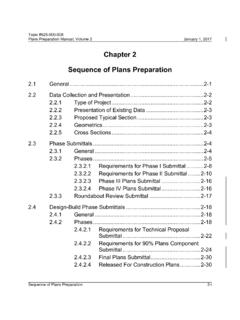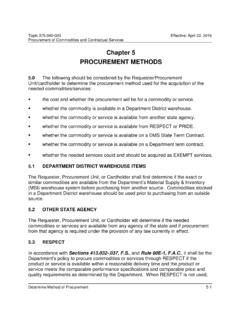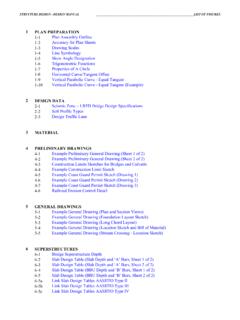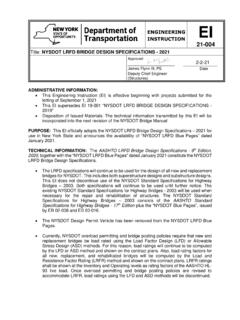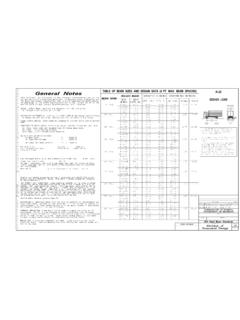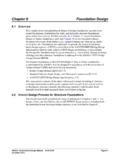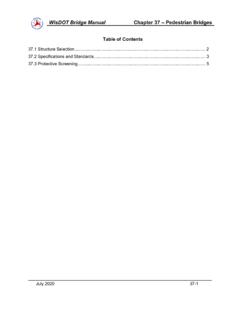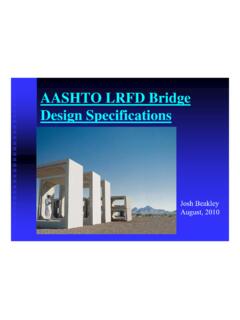Transcription of LRFD Design Example #1
1 lrfd Design Example #1:Prestressed Precast Concrete Beam Bridge DesignClick here for Table of ContentsLRFD Design Example : PRESTRESSED PRECAST CONCRETE BEAM BRIDGE DESIGNT able of Contents CoverSection 1: Project About this Design General Design ParametersSection 2: Superstructure Dead Live Load Distribution Live Load Prestressed Beam Design - Part Prestressed Beam Design - Part Traditional Deck Deck Overhang Creep and Shrinkage Expansion Joint Composite Neoprene Bearing Pad Beam StabilitySection 3: Substructure Dead Pier Cap Live Load Pier Cap Design Pier Cap Pier Column Design Pier Column Pier Foundation Design Pier Pile Vertical Load Pier Footing End Bent Live Load End Bent Design End Bent Cap Design (similar to Section ) End Bent Foundation Design End Bent Pile Vertical Load Design (similar to Section ) End Bent Backwall DesignLRFD Design ExampleTable of ContentsiSUPERSTRUCTURE DESIGNA bout this Design ExampleDescriptionThis document provides guidance for the Design of a precast, prestressed beam bridge utilizingthe aashto lrfd Bridge Design Example includes the following component designs.
2 Traditional deck Design Prestressed beam Design Composite Neoprene bearing pad Design Multi-column pier Design End bent designThe following assumptions have been incorporated in the Example : Two simple spans @ 90'-0" each, 20 degree skew. Minor horizontal curvature Multi-column pier on prestressed concrete piles. No phased construction. Two traffic railing barriers and one median barrier. No sidewalks. Permit vehicles are not considered. Design for jacking is not considered. Load rating is not addressed. No utilities on the bridge. For purposes of wind load calculation, the bridge is located in an area with a basic windspeed of 150 this Example is presented in a Mathcad document, a user can alter assumptions,constants, or equations to create a customized About this Design Example1 StandardsThe Example utilizes the following Design standards: Florida Department of Transportation Standard Specifications for Road and Bridge Construction(2010 edition) and applicable modifications.
3 aashto lrfd Bridge Design Specifications, 5th Edition, 2010. Florida Department of Transportation Structures Design Guidelines, January 2011 Edition. Florida Department of Transportation Structures Detailing Manual, January 2011 Edition. Florida Department of Transportation Design Standards, 2010 Interim The Tampa office of HDR Engineering, Inc. prepared this document for the Florida Department ofTransportation. The Structures Design Office of the Florida Department of Transportation updated the examplein materials in this document are only for general information purposes. This document is not a substitute forcompetent professional assistance. Anyone using this material does so at his or her own risk and assumes anyresulting About this Design Example2 PROJECT INFORMATIONG eneral NotesDesign and Resistance Factor Design ( lrfd ) except that the Prestressed Beamsand Prestressed Piles have been designed for Service Load.
4 Seismic analysis required (SDG ). Must meet minimum supportlength requirement ( lrfd ). Minimum 28-day Compressive Strength (psi) LocationII f`c = 3400 Traffic BarriersII (Bridge Deck) f`c = 4500 CIP Bridge DeckIV f`c = 5500 CIP SubstructureV (Special) f`c = 6000 Concrete Piling VI f`c = 8500 Prestressed superstructure is classified as slightly substructure is classfied as moderately A615, Grade 60 Concrete Top deck " (Long bridge) All other surfaces2"Substructure External surfaces not in contact with water3" External surfaces cast against earth4" Prestressed Piling3" Top of Girder Pedestals2"Concrete cover does not include reinforcement placement or fabricationtolerances, unless shown as "minimum cover".
5 See FDOT StandardSpecifications for allowable reinforcement placement Item LoadLive Load HL-93 Traffic Railing (plf)420 Wearing Surface (psf)0 Utilities (plf)0 Stay-In-Place Metal Forms (psf)20 Median Traffic Railing (plf)485 Bridge Deck Sacrificial Thickness (in) dimensions are in feet or inches, except as General Notes3 PROJECT INFORMATIOND esign ParametersDescriptionThis section provides the Design input parameters necessary for the superstructure and substructure Contents5A. General CriteriaA1. Bridge GeometryA2. Number of LanesA3. Concrete, Reinforcing and Prestressing Steel Properties9B. lrfd CriteriaB1. Dynamic Load Allowance [ lrfd ]B2. Resistance Factors [ lrfd ]B3.
6 Limit States [ lrfd ]12C. Florida DOT CriteriaC1. Chapter 1 - General requirementsC2. Chapter 2 - Loads and Load FactorsC3. Chapter 4 - Superstructure ConcreteC4. Chapter 6 - Superstructure ComponentsC5. Miscellaneous21D. SubstructureD1. End Bent GeometryD2. Pier GeometryD3. Footing GeometryD4. Pile GeometryD5. Approach Slab GeometryD6. Soil PropertiesPROJECT Design Parameters4A. General CriteriaThis section provides the general layout and input parameters for the bridge Example . A1. Bridge Geometry Horizontal ProfileA slight horizontal curvature is shown in the plan view. This curvature is used to illustrate centrifugal forces inthe substructure Design . For all other component designs, the horizontal curvature will be taken as zero.
7 PROJECT Design Parameters5In addition, the bridge is also on a skew which is defined asSkew20 deg Vertical Prof ilePROJECT Design Parameters6 Overall bridge ft Bridge Design span ft Beam Height of Height of Typical Cross-sectonSuperstructure Beam BeamType"FIB-36" Number of Beam ft Deck overhang at End Bentand ft Average PROJECT Design Parameters7A2. Number of Lanes Design Lanes [ lrfd ]Current lane configurations show two striped lanes per roadway with a traffic median barrier separating theroadways. Using the roadway clear width between barriers, Rdwywidth , the number of Design traffic lanes perroadway, Nlanes , can be calculated as:Roadway clear ft Number of Design traffic lanesper ft 3 Substructure DesignIn order to maximize the Design loads of the substructure components, pier cap negative moment, piercolumns, footing loads, etc.
8 , HL-93 vehicle loads were placed on the deck. In some cases, the placement of theloads ignored the location of the median traffic barrier. This assumption is considered to be conservative. Braking forcesThe bridge is NOT expected to become one-directional in the future. Future widening is expected to occur tothe outside if additional capacity is needed. Therefore, for braking force calculations, Nlanes3 .The designer utilized engineering judgement to ignore the location of the median barrier for live load placementfor the substructure Design and NOT ignore the median barrier for braking forces. The designer feels that theprobability exists that the combination of lanes loaded on either side of the median barrier exists.
9 However, thissame approach was not used for the braking forces since these loaded lanes at either side of the median trafficbarrier will NOT be braking in the same direction. A3. Concrete, Reinforcing and Prestressing Steel PropertiesUnit weight of conc150 pcf Modulus of elasticity forreinforcing ksi Ultimate tensile strength forprestressing ksi Modulus of elasticity forprestressing ksi PROJECT Design Parameters8B. lrfd CriteriaThe bridge components are designed in accordance with the following lrfd Design criteria:B1. Dynamic Load Allowance [ lrfd ]An impact factor will be applied to the static load of the Design truck or tandem, except for centrifugal andbraking factor for fatigue andfracture limit Impact factor for all other B2.
10 Resistance Factors [ lrfd ]Flexure and tension ofreinforced Flexure and tension ofprestressed ' Shear and torsion of normalweight B3. Limit States [ lrfd ]The lrfd defines a limit state as a condition beyond which the bridge or component ceases to satisfy theprovisions for which it was designed. There are four limit states prescribed by lrfd . These are as follows: STRENGTH LIMIT STATESLoad combinations which ensure that strength and stability, both local and global, are provided to resist thespecified statistically significant load combinations that a bridge is expected to experience in its Design distress and structural damage may occur under strength limit state, but overall structural integrityis expected to be maintained.



